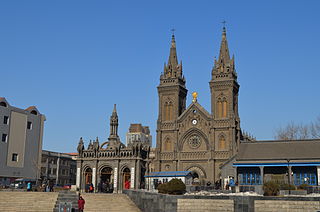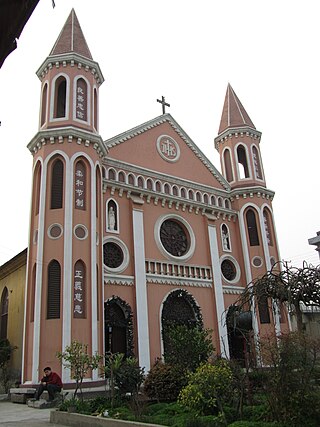
Kaifeng is a prefecture-level city in east-central Henan province, China. It is one of the Eight Ancient Capitals of China, having been the capital eight times in history, and is most known for having been the Chinese capital during the Northern Song dynasty.

The Roman Catholic Archdiocese of Kaifeng is an archdiocese located in the city of Kaifeng in Henan province, China.

The Roman Catholic Diocese of Suzhou is a diocese located in Suzhou, Jiangsu, China, under the Ecclesiastical Province of Nanjing. It covers the entire city of Suzhou.

The Sacred Heart Cathedral of Shenyang is a Roman Catholic cathedral in Shenyang, Liaoning Province, China. It is commonly called Nanguan Catholic Church and Xiaonan Catholic Church, but officially it is the Sacred Heart of Jesus Cathedral in Shenyang since the bishop of Shenyang Diocese resides here. In 2006 the Vatican agreed to Paul Pei being installed as the Bishop of Shenyang.

St. Michael's Cathedral, also called the Zhejiang Road Catholic Church, is a Catholic church in Qingdao (Tsingtao), Shandong Province, China and is the seat of the Bishop of the Diocese of Qingdao (Tsingtao). It is located in the oldest part of Qingdao, at 15 Zhejiang Road, on the east side of Zhongshan Road in Shinan District. Built by German missionaries, the cathedral stands at the top of a hill in the center of the old German-built part of the city. It is the largest example of Romanesque Revival architecture in the province, resembling a German cathedral of the 12th century.

The Cathedral of St Joseph is the Roman Catholic cathedral of the Archdiocese of Chongqing, situated on St Joseph Lane, Minsheng Road in Yuzhong District of the city of Chongqing, West China.

The Sacred Heart Cathedral also known as the Cathedral of the Sacred Heart of Jesus, is a Roman Catholic cathedral in Xuzhou, China. It is the seat of the Roman Catholic Diocese of Xuzhou. The cathedral is located at 216 Youth Road.

Jiaxing Catholic Church is a Roman Catholic Church in downtown Jiaxing, Zhejiang, China.
Joseph Gao Hongxiao was a Chinese Catholic prelate who was Bishop of the Roman Catholic Archdiocese of Kaifeng from 2007.

The Church of the Immaculate Conception, Jinan, locally known as Jiangjunmiao Catholic Church (将军庙天主堂), is the oldest Catholic church in Jinan, Shandong, China.

The Sacred Heart Cathedral, Yangzhou, also known as Catholic Church of the Sacred Heart of Jesus, is a Gothic Revival Roman Catholic cathedral in Yangzhou, Jiangsu, China. It is the seat of Apostolic Prefecture of Yangzhou.

Cathedral of the Immaculate Heart of Mary, Datong is a Roman Catholic cathedral located in Datong, Shanxi, China.

The Cathedral of Our Lady, Shuozhou is the cathedral of Shuozhou in Shanxi, China.

The Immaculate Conception Cathedral is the cathedral of the Roman Catholic Archdiocese of Taiyuan, Shanxi, China. It was founded in 1635 and rebuilt twice in 1870 and 1902, and it is the largest Catholic church building in Taiyuan.

St. Paul's Cathedral, Wenzhou, locally known as St. Paul's Cathedral, Zhouzhai Lane (周宅巷圣保禄堂), is the seat of the Catholic bishopric of the city of Wenzhou in Zhejiang, China, as well as a historic building of the country.

St. Theresa's Church, Haining is a Roman Catholic church located in the town of Chang'an, Haining, Zhejiang, China.

The Cathedral of the Angels is the Roman Catholic cathedral of the Diocese of Ningyuan, situated on Sanya Street, Xichang, in Sichuan's Liangshan Yi Autonomous Prefecture.

Sacred Heart Church or Sacred Heart of Jesus Church, commonly known as Zhongding Catholic Church, is a Catholic church in Bingzhongluo, Gongshan, Yunnan, China. It was founded by Annet Genestier in 1908, destroyed during the Cultural Revolution, and rebuilt in 1996.
Shuangshu Church (双树教堂) also known as Our Lady of the Rosary Church (玫瑰圣母堂) is a Catholic church located in Wuqing District in Tianjin, China.

St. Thérèse of Lisieux Church, Chongqing, also known as Jiangbei St. Therese Church, is a Catholic church located in Jiangbei District, Chongqing, China. Originally constructed in 1855, it underwent destruction and subsequent reconstruction multiple times during the Qing dynasty. The church was seized during the Cultural Revolution but was later returned and reopened in the late 20th century. In 2008, it was relocated to its current position.






















